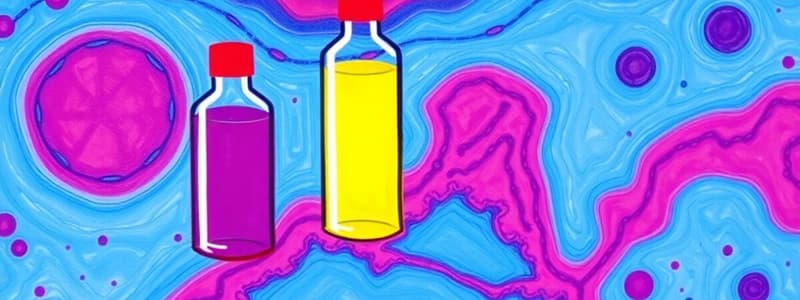Podcast
Questions and Answers
What is fixation in biological terms?
What is fixation in biological terms?
The stabilization of protein to preserve biological tissues from decay.
What is a fixative?
What is a fixative?
- A method for freezing tissue
- A chemical that stabilizes protein in tissue (correct)
- A type of microscope
- A cellular division process
Fixation prevents both autolysis and putrefaction.
Fixation prevents both autolysis and putrefaction.
True (A)
Match the types of fixatives with their description:
Match the types of fixatives with their description:
What are the primary aims of fixation?
What are the primary aims of fixation?
Which of the following is considered a commonly used fixative?
Which of the following is considered a commonly used fixative?
Fixatives also help in bringing out differences in ______ indexes.
Fixatives also help in bringing out differences in ______ indexes.
What is the optimal thickness of tissue for effective fixation?
What is the optimal thickness of tissue for effective fixation?
Why is the volume ratio of tissue to fixative important?
Why is the volume ratio of tissue to fixative important?
Formalin should remain on tissue for at least 1-2 hours before dehydration starts.
Formalin should remain on tissue for at least 1-2 hours before dehydration starts.
Flashcards are hidden until you start studying
Study Notes
Fixation Definition and Function
- Fixation stabilizes proteins in biological tissue, preventing decay through autolysis (self-digestion) or putrefaction (bacterial decay).
- Fixatives are chemicals that halt biochemical reactions and increase tissue strength/stability.
- Fixatives prevent postmortem degeneration, including autolysis and putrefaction, and maintain the relationship between cells and extracellular substances (e.g., collagen, elastin).
- They enhance tissue visibility by altering refractive indexes. Fixation aims to preserve tissue as close to its natural state as possible for examination.
Fixative Actions and Types
- Fixatives improve tissue receptiveness to dyes, often acting as mordants (linking dyes to tissue).
- Different fixatives create unique morphologic patterns and artifacts (visible changes).
- Physical fixation methods include heat (e.g., microwave) and desiccation (air drying), though less common in histology.
- Chemical fixation is primary, using additive or non-additive fixatives, and coagulant or non-coagulant fixatives.
- Additive fixatives chemically bind to tissue; examples include mercuric chloride, chromium trioxide, picric acid, formaldehyde, glutaraldehyde, glyoxal, osmium tetroxide, zinc sulfate, and zinc chloride.
- Non-additive fixatives (e.g., acetone, alcohols) dissociate water from proteins, potentially causing shrinkage and hardening.
- Coagulant fixatives create a tissue network for easy solution penetration (e.g., zinc salts, mercuric chloride, cupric sulfate, ethyl/methyl alcohol, acetone, picric acid, acetic acid [for nucleic acids]).
- Non-coagulant fixatives create gels hindering solution penetration (e.g., formaldehyde, glutaraldehyde, glyoxal, osmium tetroxide, potassium dichromate, acetic acid).
Factors Affecting Fixation
- Temperature affects tissue morphology.
- Tissue thickness is crucial; samples should be no thicker than 3mm for optimal reagent penetration.
- The volume ratio of fixative to tissue is important (15-20 times greater fixative volume than tissue volume).
- Fixation time is critical; tissue should be placed in fixative immediately after removal, and adequate fixation time (e.g., 6-8 hours for formalin) is necessary for morphology preservation to prevent distortion during subsequent processing.
Choice of Fixative
- 10% formalin is a universally used fixative.
- The choice of fixative may vary depending on the specific study requirements.
Studying That Suits You
Use AI to generate personalized quizzes and flashcards to suit your learning preferences.




